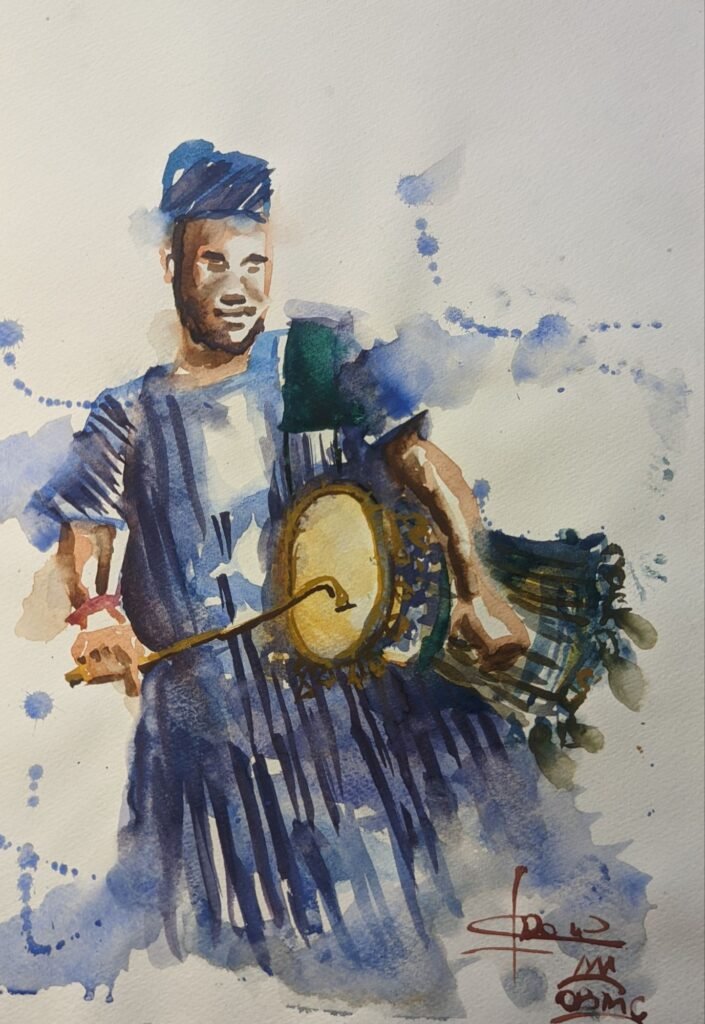
In the vibrant tapestry of African art, few forms resonate with as much cultural significance and raw energy as the depiction of music and its performers. Today, we delve into a captivating watercolor piece titled “Baba Onilu,” an artwork that not only captures a visual moment but also seems to echo with the rhythmic pulse of the drum. Painted with the fluid grace characteristic of watercolors on paper, this piece, sized at a modest 8.3 x 11.7 inches, speaks volumes about tradition, artistry, and the soul of African musical expression.
The title itself, “Baba Onilu,” immediately draws us into the heart of the scene. In many African cultures, particularly within the Yoruba tradition of Nigeria, the “Baba Onilu” translates to “Father of the Drum” or “Master Drummer.” This title signifies not just proficiency in playing the instrument but also a deep understanding of its cultural and spiritual significance. The drummer is often a respected figure in the community, a storyteller, a historian, and a vital part of ceremonies and celebrations.
The artist’s choice of watercolor as a medium is particularly fitting for this subject. The translucent washes of blue dominate the figure’s attire, suggesting the flowing fabric of traditional Yoruba dress. Hints of white and darker indigo tones create depth and texture, allowing the garment to drape and move with an almost musical quality itself. The cap worn by the Baba Onilu is rendered in a similar palette, completing his traditional ensemble.
The central focus, of course, is the drum. Painted in warm yellows and browns, the instrument stands out against the cooler tones of the figure’s clothing. The artist has paid close attention to the drum’s form, suggesting the stretched membrane and the cylindrical body. A beater, held firmly in the drummer’s hand, is poised to strike, hinting at the vibrant rhythms about to fill the air. The way the Baba Onilu holds the drum, seemingly embracing it, speaks to the intimate connection between the musician and his instrument. A patterned cloth, draped around his waist, adds another layer of visual interest and cultural context, with suggestions of green and white woven into its fabric.
The background of the watercolor is kept deliberately loose and suggestive. Splatters and washes of blue and other muted tones create an atmospheric space that doesn’t distract from the central figure but rather enhances the overall feeling of movement and energy. These abstract elements could be interpreted as the reverberations of the drumbeat, the invisible waves of sound that emanate from the instrument and envelop the scene. The focus remains firmly on the Baba Onilu, highlighting his pivotal role in creating the music.
The artist’s technique showcases a confident command of the watercolor medium. The fluidity of the washes creates a sense of dynamism, mirroring the rhythmic movements of the drummer. The way the colors blend and bleed into one another adds a layer of organic vibrancy to the piece. While the overall style is somewhat impressionistic, key elements like the drummer’s hands and the drum itself retain enough detail to ground the image in reality.
This artwork, being identified as “African Water Colour,” speaks to a broader artistic tradition within the continent. Watercolor, with its ability to capture light and movement, has been embraced by many African artists to depict diverse aspects of their cultures, from portraiture to landscapes to scenes of daily life and ritual. “Baba Onilu” fits seamlessly into this tradition, celebrating a significant aspect of African cultural expression through a medium that lends itself to capturing its ephemeral nature.
The size of the artwork, 8.3 x 11.7 inches (A4), suggests an intimacy. It invites the viewer to come closer, to appreciate the nuances of the watercolor washes and the expressive portrayal of the Baba Onilu. Despite its modest dimensions, the painting possesses a powerful presence, its energy contained within the boundaries of the paper, ready to be unleashed in the viewer’s imagination.
“Baba Onilu” is more than just a painting; it is a visual ode to the power of music and the vital role of the musician in African culture. It captures a moment in time, a fleeting instant just before or during a performance, yet it resonates with the timeless tradition of drumming. This watercolor serves as a vibrant reminder of the rich artistic and cultural heritage of Africa, a heritage that continues to inspire and captivate audiences worldwide. It is a testament to the ability of art to transcend language and communicate the universal language of rhythm and soul.
0 Comments